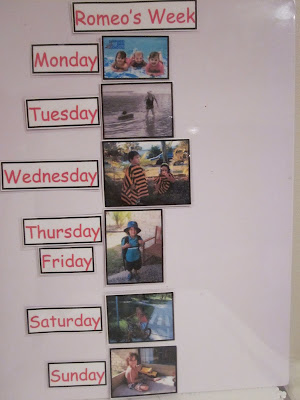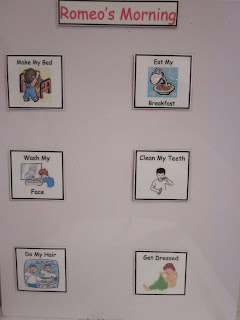
When I'm teaching Pre-schoolers about shapes I like to use the book The Shape Of Things by Dayle Ann Dodds. The shapes are big and colourful, and a lovely way to subtly introduce the children's ears to alliteration.
Teaching Shapes to Preschoolers can be so much fun! Below are some fun activities that will begin to help your young children recognise simple shapes.
- Snack Shapes - Cut bread into shapes and ask them to eat the shapes. You can create a mix of squares and triangles and ask your child to eat the squares first. Not only he or she will eat a lot of bread in this way, but will also learn to differentiate between a square and a triangle. For an added variation, cut cheese into shapes as well to make shape sandwiches.
- Shape BINGO -Use the printable BINGO cards below to play a friendly game of Shape BINGO with your preschooler. They will have fun, and learn at the same time.
Preschoolers only need to know about the basic shapes, such as squares, circles, triangles, etc. They will learn the more complex shapes in the later years of their education.
- SHAPE RUBBINGS - Try one or both of these ideas with your group.
On cardboard, draw shapes such as circles, squares, triangles, and rectangles. Squeeze glue from a bottle over the shape outlines and allow it to dry. Then let your children place pieces of paper on top of the shapes and color over them with the sides of crayons to make rubbings of the glue outlines.
Cut familiar shapes out of cardboard and attach them to a tabletop with double-sided tape. Have the children place their papers on top of the shapes and rub over them with crayons.
- COOPERATIVE SHAPE COLLAGES - Draw a familiar shape, such as a circle, in the middle of a piece of butcher paper. Invite your children to look through magazines and tear or cut out pictures of circular shaped items. Then have them glue the pictures onto the butcher paper around the circle in the center. Let the children make collages for other familiar shapes to display together on a wall or a bulletin board.
- CREATING WITH SHAPES - From several colors of poster board, cut out assorted sizes of circles, squares, triangles, and rectangles. Store the shapes in a box or a zipper-top bag. Let your children take turns arranging the shapes on a tabletop or on the floor any way they wish to create pictures.
- TRACE AND MATCH SHAPE GAMES - Cut several familiar shapes out of cardboard to use for these games. Sit with your children in a circle and lay out the shapes in the middle. While the children close their eyes, trace around one of the shapes on a piece of paper. When the children open their eyes, have them guess which shape matches the traced one. Continue with the remaining shapes.
Using a marker, trace around each shape on a large piece of poster board. Let the children try matching the shapes by placing them on top of the tracings.
- SHAPE LACING CARDS - Cut familiar shapes out of cardboard and punch holes around the edges. On each shape, tie one end of a long piece of yarn through one of the holes. Wrap tape around the other end of the yarn to form a lacing needle. Set out the shapes and invite your children to lace the yarn in and out of the holes (activity requires supervision).
- SHAPES, SHAPES, SHAPES Tune: “Three Blind Mice” Shapes, shapes, shapes; shapes, shapes, shapes.We love shapes, we love shapes.There’re squares and circles for me and you,Triangles, rectangles, ovals, too,Hearts and diamonds, to name a few.Yes, we love shapes.
- PUZZLES - bring out any puzzles that have shapes in them. Puzzles provide a great opportunity to talk about the properties of each shape.
DIAMONDS
FIND A DIAMOND Tune: “Clementine”
Find a diamond, find a diamond,
Find a diamond on the floor.
Put your finger on the diamond,
On the diamond on the floor.
Find a diamond, find a diamond,
Find a diamond on the floor.
Put your two feet on the diamond,
On the diamond on the floor.
- Bake diamond-shaped cookies for kites. Let your children decorate them with frosting and sprinkles and add licorice whips for kite strings.
- Use masking tape to make a large diamond shape on the floor. Have the children try tossing beanbags inside the shape.
- Show the children how to glue craft sticks onto paper in diamond shapes to make kites. Have them decorate their kites as desired and glue on pieces of string.
OVALS
WAVE YOUR OVAL IN THE AIR Tune: “If You’re Happy and You Know It”
Wave your oval in the air, in the air.
Wave your oval in the air, in the air.
Wave your oval in the air,
Then wave it here and there.
Wave your oval in the air, in the air.
Wave your oval at your toe, at your toe.
Wave your oval at your toe, at your toe.
Wave your oval at your toe,
Then wave it to and fro.
Wave your oval at your toe, at your toe.
- Oval Ladybugs: Make thumbprints on light colored paper with red paint. When dry, use fine point markers to add spots, legs, and a head to each print.
- Cut five ovals out of felt and use a marker to number them from 1 to 5. Set out a bowl containing 15 oval-shaped dried beans. Then, sitting with each of your children in turn, have them name the numerals on the ovals and place a matching number of beans on each one. (Note: Activities using small objects require close supervision.)
- Have the children help make burritos with oval black beans.
CIRCLES
LET'S GO ROUND THE HULA-HOOP Tune: "London Bridge"
Let's go round the Hula-Hoop,
Hula-Hoop, Hula-Hoop.
Let's go round the Hula-Hoop,
Round the circle.
Round and round and round we go,
Round we go, round we go.
Round and round and round we go,
Round the circle.
- Place a Hula-Hoop flat on the floor. Then invite your children to try such activities as these.
Walk, crawl, or tiptoe around the hoop.Toss beanbags inside the hoop.
- Pizza: Cut a large circle out of orange felt for a cheesy pizza. Cut out smaller red circles for pepperoni, black circles for olives, brown circles for sausage, and green rings for peppers.
- Place folded paper towels in shallow containers and pour on tempera paint. Let your children make circle prints by pressing the ends of corks onto the paint, then onto paper. When the paint has dried, have the children use markers to turn their prints into pictures.
RECTANGLES
DO YOU KNOW THE RECTANGLE? Tune: "The Muffin Man"
Do you know the rectangle, (Hold up a rectangle.)
The rectangle, the rectangle?
Do you know the rectangle?
It has four sides like this. (Point to four sides.)
Two are long and two are short, (Point to long sides, then short sides.)
Two are short, two are short.
Two are long and two are short.
It has four sides like this. (Point to four sides.)
- Have your children draw pictures on rectangular pieces of construction paper, encouraging them to fill up the space as much as possible. Then cut each child's paper into several rectangular puzzle pieces and challenge the child to put his or her puzzle back together.
- Collect rectangular sponges and pour tempera paint into shallow containers. Invite your children to dip the sponges into the paint and press them onto a rectangular piece of butcher paper to make a print mural.
HEARTS
RED HEARTS, RED HEARTS Tune: "Twinkle, Twinkle, Little Star"
Red hearts, red hearts here and there,
Red hearts, red hearts everywhere.
All the hearts are here to say
Let's be special friends today.
Red hearts, red hearts here and there,
Red hearts, red hearts everywhere.
- Bake heart-shaped cookies to decorate with frosting and sprinkles.
- Make stencils by using a craft knife to cut heart-shaped holes out of cardboard squares. Tape the stencils on top of white paper and let your children sponge-paint over them to fill in the holes. When the paint has dried, remove the stencils to reveal the sponge-painted hearts.
TRIANGLES
TRIANGLES, TRIANGLES Tune: "Jingle Bells"
Triangles, triangles,
Triangles I see.
Count the points and count the sides,
Count them 1, 2, 3.
Triangles, triangles,
Just for you and me.
Count the points and count the sides,
Count them 1, 2, 3.
- Ice Cream Cones: Glue brown triangle cone shapes onto paper. Add colorful paper circles for scoops of ice cream.
- Let your children make collages using triangles cut from fabric scraps
SQUARES
I'M A SHAPE THAT HAS FOUR SIDES Tune: "Mary Had a Little Lamb"
I'm a shape that has four sides,
Has four sides, has four sides.
I'm a shape that has four sides,
And they are all the same.
Count my points, I have four too,
Have four too, have four too.
Count my points, I have four too.
And Square is my name.
- Mosaics: Cut 1-inch squares out of bright coloured paper. Let the children glue the squares in designs on black paper.
- Picture Frames: Show the children how to glue four jumbo craft sticks together to make a square frame. Have them decorate their frames with such items as stickers, beads, or seeds.









 We are fortunate enough to live on the Sunshine Coast in Queensland, Australia! Even better we live 10 minutes down the road from Australia Zoo so each year we buy a family pass and spend hour upon hour at the zoo. Considering the number of hours we spend there, the boys and I still manage to find new and exciting things to discover on each visit. Today was a special visit as Bindi was performing, and we spent lots of time looking at the Tigers after their feeding session. Our trip home was full of lots of exciting chatter from Master 2 and Master 4 about the Tigers, where they come from, what they eat, why they have stripes etc. Master 4 and I decided to look through our book shelf and find one of our favourite books, The Tiger Who Came For Tea.
We are fortunate enough to live on the Sunshine Coast in Queensland, Australia! Even better we live 10 minutes down the road from Australia Zoo so each year we buy a family pass and spend hour upon hour at the zoo. Considering the number of hours we spend there, the boys and I still manage to find new and exciting things to discover on each visit. Today was a special visit as Bindi was performing, and we spent lots of time looking at the Tigers after their feeding session. Our trip home was full of lots of exciting chatter from Master 2 and Master 4 about the Tigers, where they come from, what they eat, why they have stripes etc. Master 4 and I decided to look through our book shelf and find one of our favourite books, The Tiger Who Came For Tea.



























